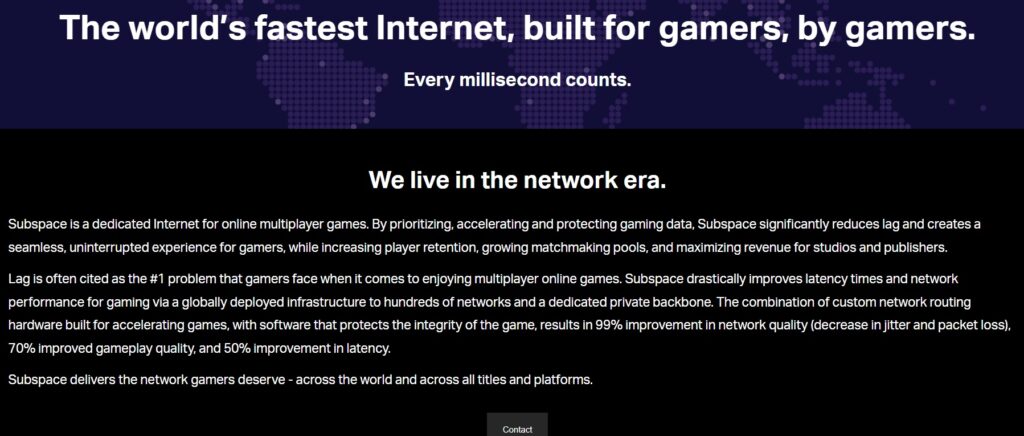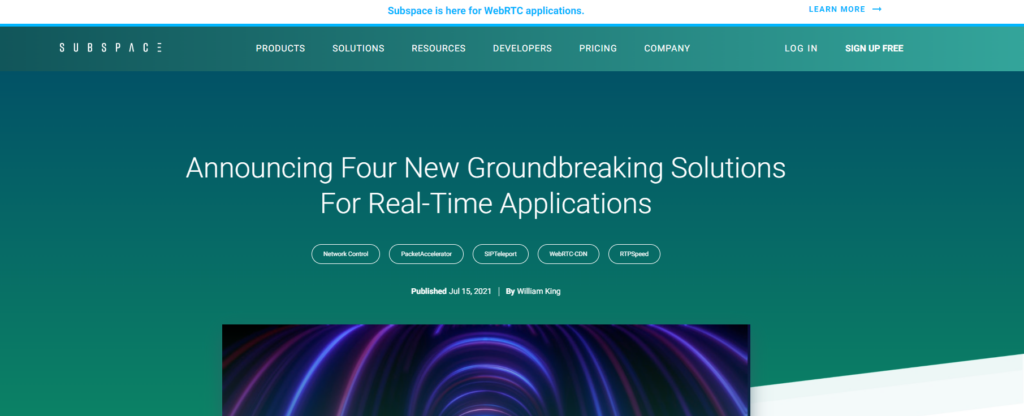Subspace (not to be confused with Subspace Labs), the once-promising CDN startup, closed on May 13, 2022. It joins the ranks of EdgeGravity and Instart Logic as promising ventures that fizzled out. It’s unfortunate because dozens of employees lost their high-paying jobs in this economy where companies are laying off by the thousands.
The last CDN startup to close its doors at this scale was Instart Logic. After raising $140M in several rounds, the startup shut its doors a decade later, selling its assets to Akamai for a rumored ~$30M. When a CDN startup shuts down, it reverberates across the globe to those who follow the industry.
Why did this happen to Subspace? Could it have been avoided? There are lots of unanswered questions surrounding Subspace. Although our observations are speculative, trying to understand what happened is not rocket science. CDNs have been around for more than a decade. Products, pricing, positioning, and competitive strategy are somewhat similar from one vendor to the next.
Official Statement
Here is the official company statement on LinkedIn. We aim to capture the story before pieces of it disappear from the internet, as it happened with Instart Logic. In a few weeks, the Subspace website will shut down, and there will be a scant record of the startup.
We regret to announce that effective May 13, 2022, Subspace will be shutting down its global network and business operations. We want to thank our team, customers, investors, and advocates for their support. Our technology is incredibly unique and advanced, but market conditions have changed in the last several months and made it difficult to execute at the scale we needed, to meet our customers’ demands. Since our founding in 2018 and service launch in March 2020, Subspace envisioned a future where data rich and latency sensitive applications could flourish globally, regardless of internet weather, congestion & bottlenecks. Although our ability to execute on this vision faltered due to financial constraints, we still believe that the promise of web 3.0 and the Metaverse requires better connectivity than the public internet and that the vision of Subspace will be proven in the future.
Source: LinkedIn
Background
- Company: Subspace Inc.
- Founded: 2018
- Launched: 2020
- Shut Down: May 13, 2022
- HQ: Los Angeles
- Raised: $26M
- Founders: Bayan Towfiq and William King
- Products: SIP, WebRTC, Application Acceleration, and Load Balancing
- Target Market: Gaming, real-time video, sports betting, and real-time applications
- Customers: Gaming companies, including FunPlus
Subspace was a well-liked company around the world. The LinkedIn comments are a testament to this fact. Not only did the startup hire a rockstar team from Riot Games, SpaceX, Google, Akamai, and other prestigious organizations, but their technology stack stood out, helping improve the real-time interactivity for several.
In industries like online auctions, real-time interactions are a technical challenge for CDNs and always have been. One solution developed to address this challenge is WebRTC. WebRTC was designed to deal with latency issues of online auctions, gambling, multi-player gaming, etc. When Subspace was around, this was an area of focus.
Subspace Launch
Subspace introduced itself to the public in May 2020 in an article by GameBeat author Dean Takahashi. Heads up if you’re reading the article. It reads more like a first draft than a final edit. He called Subspace a new type of CDN for games. Apart from this article, there wasn’t much information about the startup back then. The takeaways from the GameBeat article:
- Subspace focuses on real-time applications (betting, gaming, auctions, etc.)
- Deployed physical infrastructure in hundreds of cities globally
- Spent money lighting up dark fiber in hundreds of cities worldwide. “We are lighting up dark fiber with our own lasers” and “using our own wavelengths on existing fiber optic systems”
- Built a private network with zero packet loss
- Generated eight figures in revenue in private launch
- Supported millions of players on the Subspace network
- The biggest gaming companies in the world worked with the startup
- “Subspace builds a map of the internet, finds the paths that are fast and routes the traffic.”
The claims and talking points above were bold and ambitious. Many were convinced, including us, that the startup was on to something big.
Business Model
Like most startups, the Subspace business model went through various iterations in its short lifespan. In October 2020, the home page read as follows:

On July 15, 2021, there was a new home page and message. In the span of nine months, Subspace introduced four products: 1) WebRTC-CDN, 2) SIPTeleport, 3) PacketAccelerator, and 4) GlobalLoadBalancer.


Comparing messages from Oct 2020 to July 2021, the focus seemed to change from gaming to gaming and telephony solutions. SIP is a core product for telcos-they sell SIP trunking solutions, and it plays a role in UCaaS and Unified Communications (UC&C).
Challenges
One of the challenges initially facing Subspace was its narrow market focus. Subspace targeted the gaming niche and was successful. In the first couple of years (private launch), the startup generated eight figures in revenue, according to the CEO.
Eight figures can mean anything. Perhaps it was $10M, $15M, $20M, or more. Whatever the amount, it was quite an achievement for the startup. How could a startup sell so much so fast? Subspace employed staff from gaming companies like Riot Games. Perhaps they were well connected to the gaming industry and closed deals quickly.
When Instart Logic first started, it focused on eCommerce. eCommerce companies are the ideal CDN customer because they are usually flush with cash and pay vendors handsomely to shave off a few milliseconds off page load times. After all, there is a direct correlation between latency and revenue in this niche.
However, focusing too narrowly on gaming or eCommerce is a problem. In the gaming industry, entrenched players like Akamai dominate the vertical. Same with eCommerce. The CDNs working in these verticals have been doing it for years. Many have created features, processes, and best practices developed over years of working with gaming companies.
No startup will change this picture regardless of how cool their software stack is or how much money they raised. The better approach would have been to target the larger market, including gaming, media, education, hospitality, travel, gambling, education, etc.
However, focusing on a limited target market isn’t a deal-breaker. No one has gotten it right out of the door, including today’s successful CDNs. It takes time to find your groove, sometimes years. The two actions that eventually led to Subspace’s finality were infrastructure and headcount costs.
Infrastructure and Headcount
In the GameBeat article, Subspace stated they deployed infrastructure in hundreds of cities. In our world, infrastructure usually means servers, routers, switches, colo, transit, and power. The CAPEX for this much infrastructure would be in the millions. And the monthly cost for running this infrastructure would also be in the millions annually. That’s a deal-breaker.
Another area Subspace miscalculated was in headcount. At one time, Subspace employed 150 to 160 people. Several were expensive engineers. If a startup hires from Google, Akamai, SpaceX, etc., they will have to pay high salaries. They hired too many too fast. For a startup like Subspace, it was overkill. There is nothing wrong with paying high wages; the problem is adding too many too soon. That was also a deal-breaker.
In May 2021, Subspace axed half of its staff. Multiple departments were hit, including engineering and sales. That was also tragic, and the first sign of trouble began to emerge.
Ultimately, infrastructure and headcount costs determined the fate of Subspace. Although it hurts right now for those impacted by the tragedy, things will get better eventually. Look at Instart Logic. Some of its employees went to work for Google, and others started new ventures.
Conclusion
Subspace might have avoided this situation by practicing more financial discipline. Everybody was rooting for the startup, and one thing our industry needs more is startups with great ideas and innovative business models. The lesson learned is that next time a startup plans to build a global network and compete in the CDN industry, start with a small network footprint and a couple of dozen killer engineers. Then as revenue grows, hire headcount, and build out the network footprint.
I hope we see dozens of innovative new startups like Subspace and Instart Logic in the future, who build global network footprints and introduce game-changing products. However, times have changed. It looks like these days are over because it’s much easier to build on AWS and manage a software stack than maintain hardware globally.

